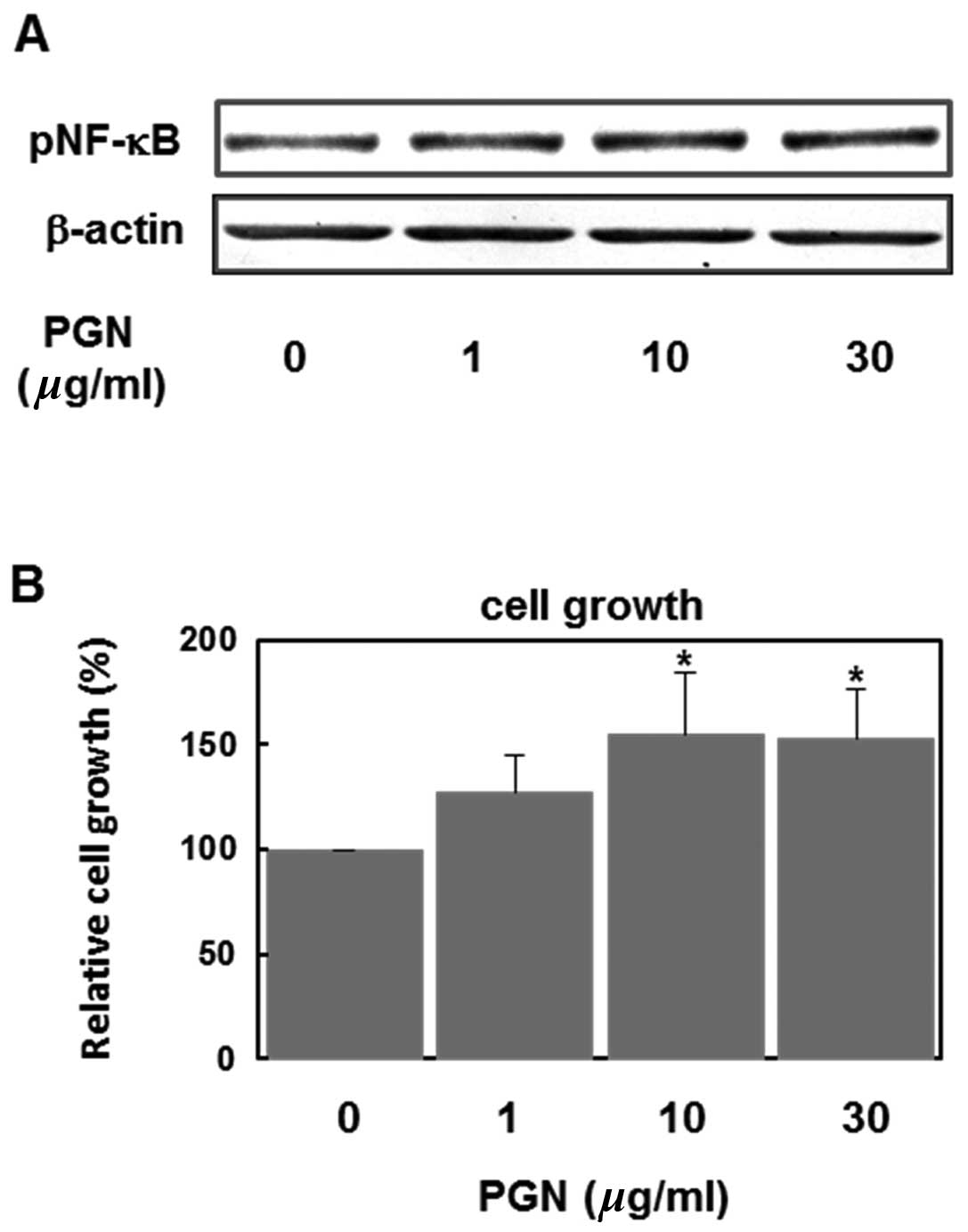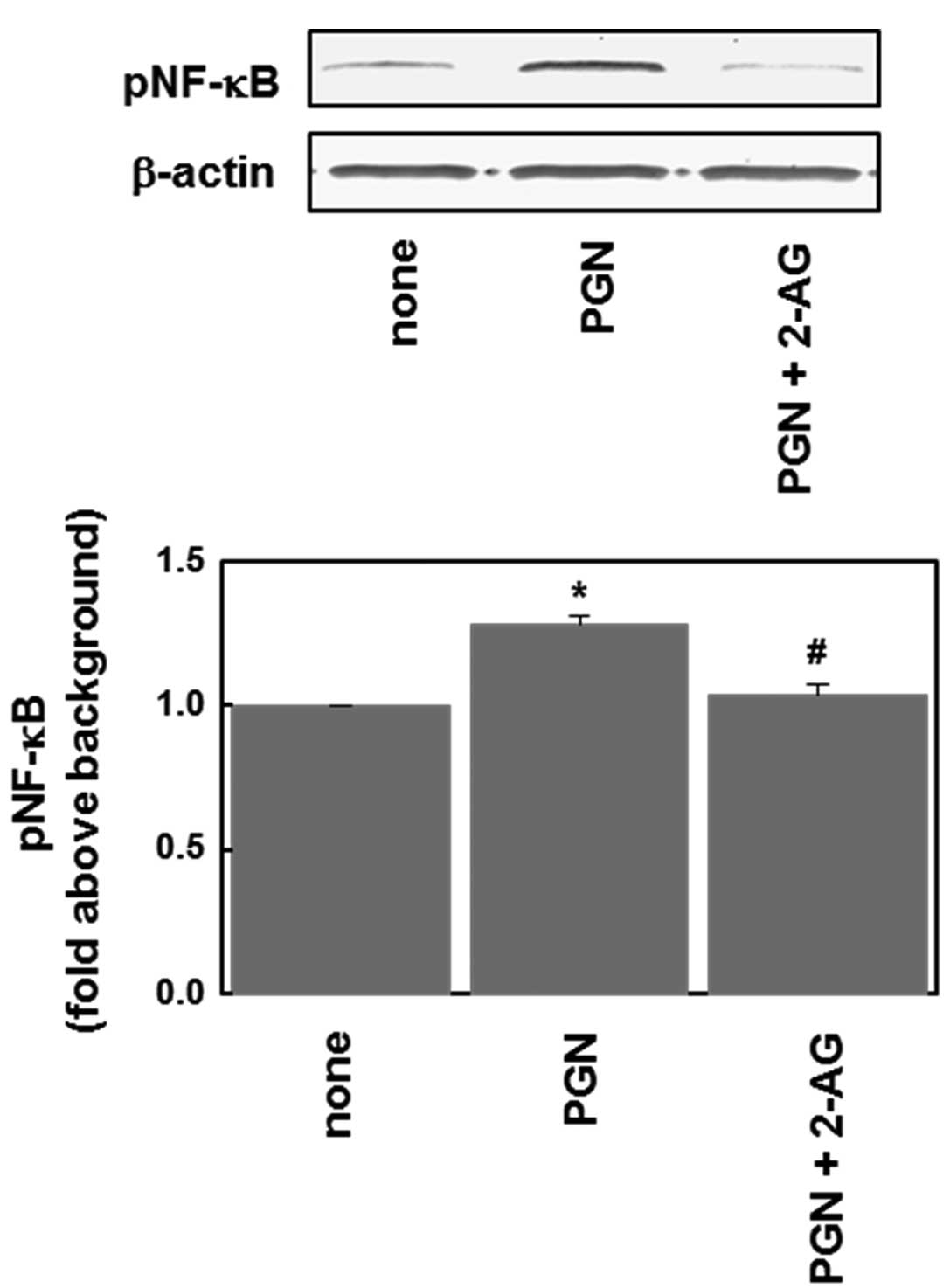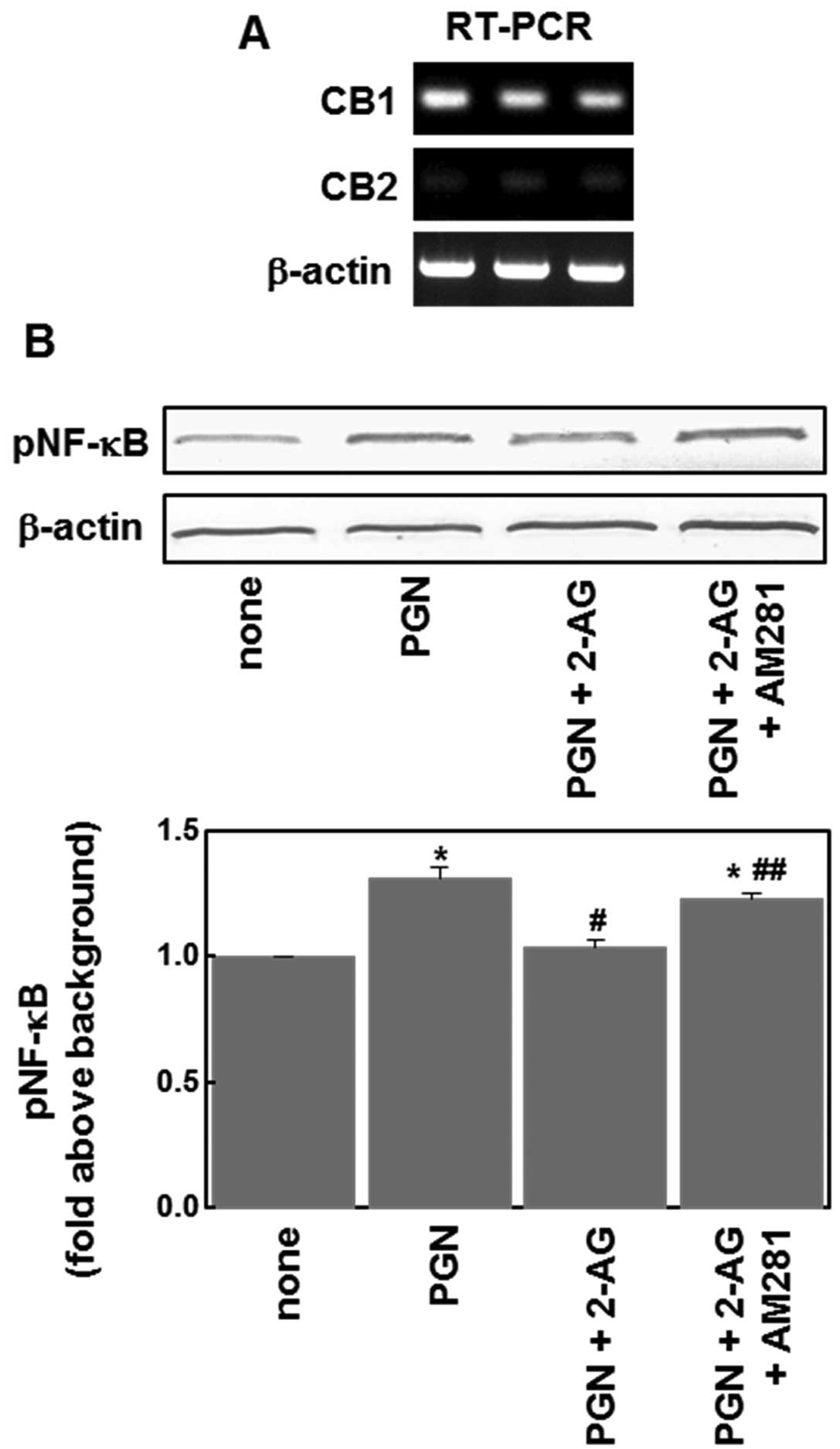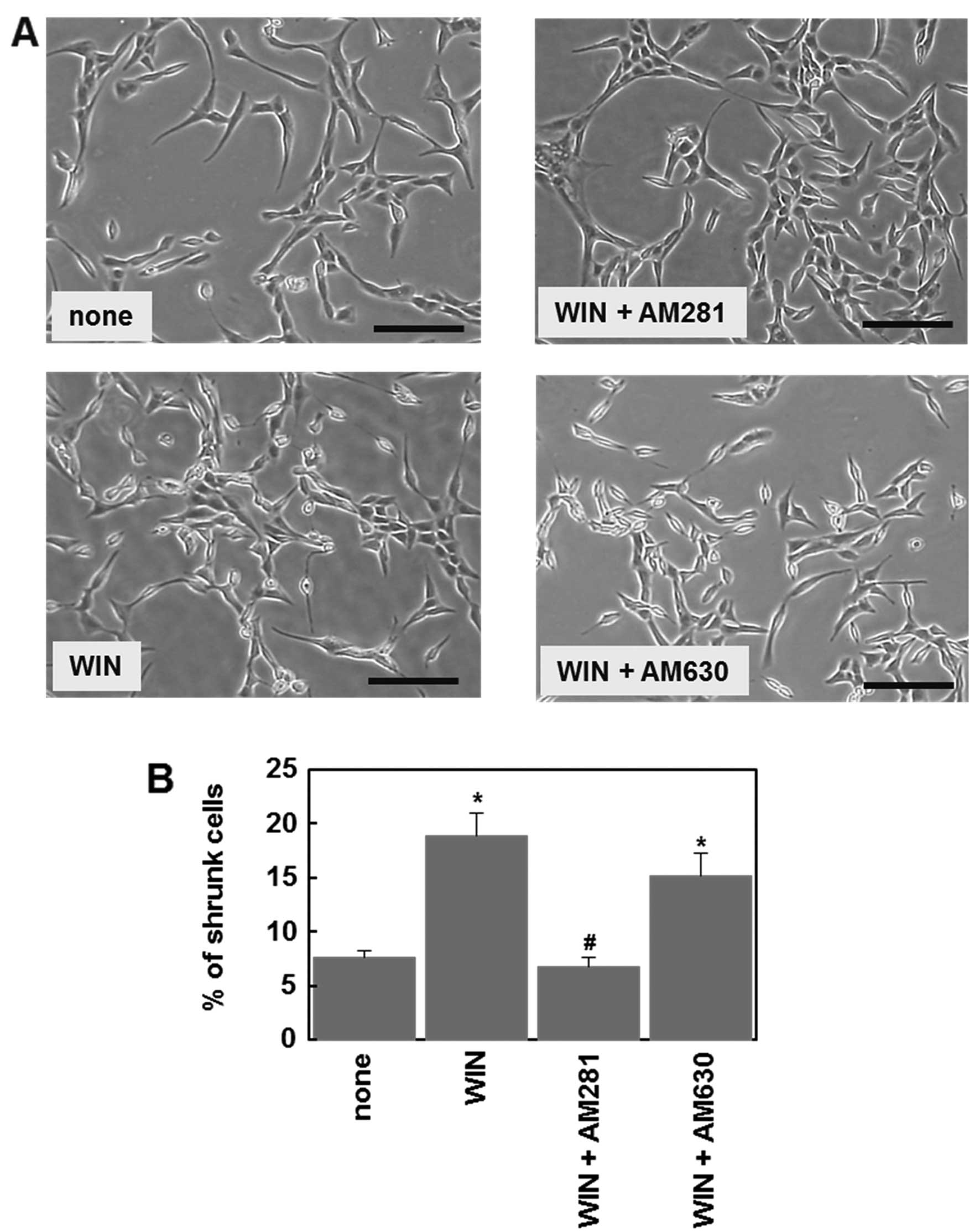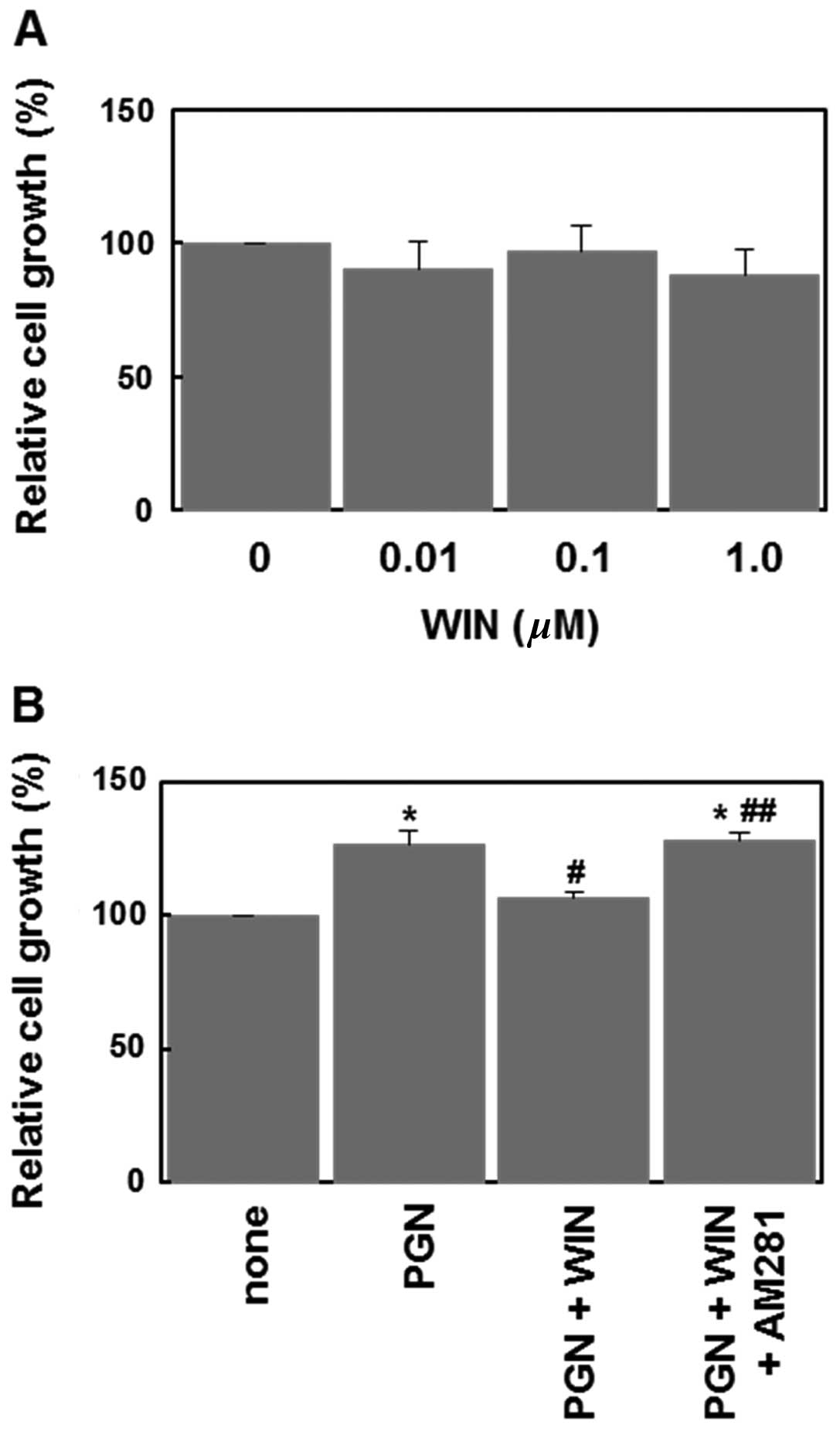Cannabinoids inhibit peptidoglycan-induced phosphorylation of NF-κB and cell growth in U87MG human malignant glioma cells
- Authors:
- Published online on: July 26, 2012 https://doi.org/10.3892/or.2012.1937
- Pages: 1176-1180
Abstract
Introduction
Bacteria stimulate the innate host immune system and lead to the release of inflammatory molecules such as cytokines and chemokines. Lipopolysaccharide (LPS) and peptidoglycan (PGN) are the main cell wall components of Gram-negative and Gram-positive bacteria, respectively. LPS and PGN stimulate different Toll-like receptors (TLRs), TLR-4 and TLR-2 respectively, and activate a number of inflammatory pathways, including the transcription factor, nuclear factor (NF)-κB (1,2). NF-κB is the key transcription factor involved in the inflammatory responses, and also plays a critical role in tumor cell survival, growth and migration. Many of the signal pathways implicated in tumors converge to the NF-κB signal. Its activation aggravates tumors, while its suppression inhibits tumor cell growth (3–5). Therefore, the NF-κB signaling pathway has emerged as one of the attractive targets for the treatment of many types of tumor, including glioblastoma (6).
The endocannabinoid system, consisting of two types of G-protein-coupled cannabinoid receptors (CB1 and CB2) and their endogenous ligands (endocannabinoids) (7), has been implicated in a variety of physiological and pathological conditions, including inflammation and tumor progression. The CB1 receptor is abundantly expressed in the CNS, while the CB2 receptor is predominantly expressed by immune cells. Endogenous and exogenous cannabinoids exert anti-inflammatory and antitumor effects (8–10). However, the precise mechanisms underlying these actions are not yet fully understood.
In the present study, we examined effects of cannabinoids on PGN-induced NF-κB activation and cell growth using U87MG human malignant glioma cells. We demonstrate that cannabinoids suppress the PGN-induced phosphorylation of NF-κB and cell growth in a CB1-dependent manner. Our findings provide a mechanistic basis for opening up new therapeutic approaches of treating or preventing brain tumors aggravated by inflammation.
Materials and methods
Chemicals
PGN, 2-arachidonoylglycerol (2-AG), WIN55,212-2 and Dulbecco’s modified Eagle’s medium (DMEM) were obtained from Wako Pure Chemical Industries, Ltd. (Osaka, Japan). AM281 (CB1 specific antagonist) and AM630 (CB2 specific antagonist) were obtained from Calbiochem (La Jolla, CA, USA). Fetal bovine serum (FBS) was obtained from Invitrogen Corporation (Carlsbad, CA, USA). Anti-phosphorylated (phospho)-specific NF-κB p65 (Ser536), anti-β-actin and horseradish peroxidase (HRP)-linked anti-rabbit IgG were purchased from Cell Signaling Technology, Inc. (Danvers, MA, USA).
Cell culture
U87MG human malignant glioma cells were provided by Dr Nakata. The cells were maintained in DMEM containing 10% FBS at 37°C in a 5% CO2 incubator.
NF-κB activity assay
To determine the effect of 2-AG on NF-κB activity, we investigated the phospho-NF-κB level using western blot analyses. An increase in the phospho-NF-κB level indicates the NF-κB activation levels. The U87MG human malignant glioma cells were incubated in DMEM containing serum for 24 h and pre-treated with 2-AG (1 μM) for 10 min, and then treated with PGN (1–30 μg/ml) for 16 h. Western blot analyses were performed using phospho-NF-κB p65 (Ser536) antibody and anti-β-actin antibody.
Western blot analysis
Western blot analysis was performed as described previously (11).
Reverse transcription-mediated polymerase chain reaction (RT-PCR) analysis
To evaluate the expression patterns of CB1 and CB2 mRNA in the cells, RT-PCR was performed as follows: briefly, RNA was extracted from the cells and reverse transcribed by using reverse transcriptase ReverTra Ace (Toyobo, Tokyo, Japan). PCR-based subtype-specific gene amplification for CB1, CB2 and β-actin was performed with LA Taq (Takara, Tokyo, Japan) using the following sets of primers: 5′-caggcctt cctaccacttcat-3′ and 5′-accccacccagtttgaacaga-3′ for CB1, 5′-aagccctcgtacctgttcat-3′ and 5′-acagaggctgtgaaggtcat-3′ for CB2, and 5′-atggtgggtatgggtcagaag-3′ and 5′-ctggggtgttgaagg tctcaa-3′ for β-actin.
Microscopic analysis
U87MG cells were seeded on 35-mm dishes at a density of 1×103 cells/dish. After a 24-h incubation, the cells in DMEM with serum were treated with 1 μM WIN55,212-2, a combination of WIN55,212-2 (1 μM) and AM281 (1 μM) or a combination of WIN55,212-2 (1 μM) and AM630 (1 μM) for 72 h. Morphological changes of cells were assessed by light microscopy.
Cell proliferation assay
Cell proliferation was analyzed using the Cell Counting kit 8 (Wako Pure Chemical Industries, Ltd.). U87MG human malignant glioma cells were seeded in 96-well plates at a density of 1×103 cells/well. After a 24-h incubation, the cells were treated with PGN, WIN55,212-2 or AM281 for 72 h. The cells were then incubated with 10 μl WST-8 for 2 h. The absorbance of the colored formazan product produced by mitochondrial dehydrogenases in metabolically active cells was recorded at 450 nm as the background value. Cell proliferation was expressed as a percentage of the absorbance obtained in the treated wells relative to that in the untreated (control) wells.
Statistical analysis
Data are presented as the means ± SEM from at least three independent experiments. Statistical analyses were performed using ANOVA followed by Dunnett’s test and the results were considered statistically significant when P<0.01.
Results
PGN enhances phosphorylation of NF-κB and cell growth
First, we examined effects of PGN, a major cell wall component of Gram-positive bacteria, on NF-κB activation and cell growth. As shown in Fig. 1A, PGN (1–30 μg/ml) increased the level of phospho-NF-κB (p65) in a concentration-dependent manner, indicating that PGN activates the NF-κB signaling pathways in U87MG human glioblastoma cells. PGN also accelerated the cell growth of these cells in a concentration-dependent manner (Fig. 1B).
Endocannabinoid 2-AG inhibits PGN-induced phosphorylation of NF-κB
We then examined the effects of cannabinoids. Anandamide and 2-AG are the two main endocannabinoids, and activate both CB1 and CB2 cannabinoid receptors. Anandamide behaves as a partial agonist at these cannabinoid receptors and also activates the vanilloid receptor (TRPV1). 2-AG acts as a full agonist at cannabinoid receptors and does not interact with TRPV1, suggesting that 2-AG is a true natural ligand for cannabinoid receptors (7). Therefore, to examine the cannabinoid receptor-dependent effects we used 2-AG rather than anandamide as an endocannabinoid. As shown in Fig. 2, the PGN (10 μg/ml)-induced phosphorylation of NF-κB was significantly inhibited by 2-AG (1 μM).
2-AG inhibits PGN-induced phosphorylation of NF-κB via CB1 receptor
To examine whether cannabinoid receptors are involved in the inhibitory effect of 2-AG, we first examined the expression of CB1 and CB2 mRNAs in U87MG glioblastoma cells using RT-PCR. The CB1 receptor expression was detectable in these cells, but CB2 receptor expression was below the limit of detection (Fig. 3A). We then examined effects of the CB1 receptor antagonist, AM281, and found that AM281 (1 μM) reversed the suppressive effect of 2-AG on PGN-induced NF-κB phosphorylation (Fig. 3B). These results indicate that CB1 receptors are involved in the effects of 2-AG on the NF-κB signaling pathway.
Cannabinoid agonist WIN55,212-2 affects the cell morphology via CB1 receptor
To further confirm the presence of functional CB1 receptors in U87MG cells, we examined effect of cannabinoid receptor antagonists on cannabinoid-induced morphological changes. Cell morphology was assessed after a 72-h treatment with drugs. Due to the long incubation time, we used the cannabinoid agonist, WIN55,212-2, instead of 2-AG, which is easily degraded by endogenous enzymes, such as monoacylglycerol lipase. Microscopic analysis showed that treatment with WIN55,212-2 (1 μM) affected the cell morphology and increased the number of shrunken cells (Fig. 4A). The CB1 antagonist, AM281 (1 μM), but not the CB2 antagonist, AM630 (1 μM), prevented the WIN55,212-2-induced morphological change (Fig. 4). These results indicate that functional CB1 receptors are expressed in U87MG cells, consistent with the above observation (Fig. 3).
WIN55,212-2 inhibits PGN-induced cell proliferation via CB1 receptor
Finally, we examined the ability of WIN55,212-2 to inhibit PGN-induced cell proliferation. When applied alone, WIN55,212-2 (0.01–1 μM) failed to significantly affect the cell proliferation (Fig. 5A). However, WIN55,212-2 (1 μM) significantly inhibited PGN-induced cell proliferation (Fig. 5B). This effect of WIN55,212-2 was reversed by AM281 (Fig. 5B). These results indicate that the activation of CB1 receptors suppresses the PGN-induced cell proliferation in U87MG human glioblastoma cells.
Discussion
Several lines of evidence have shown that cannabinoids exert a variety of physiological and pharmacological effects (7,8,12). Notably, cannabinoids inhibit tumor growth and have been proposed as potential antitumor agents (8,13,14). However, the mechanisms by which cannabinoids prevent tumor progression are not yet fully understood. Our data suggest the possibility that the antitumor and protective action of cannabinoids against PGN-induced inflammatory assaults might be associated with their ability to suppress the phosphorylation of NF-κB via CB1 receptor signaling.
PGN is a characteristic cell-wall component of Gram-positive bacteria that can stimulate inflammatory signaling in several types of cells. In the present study, we found that PGN potently induced NF-κB phosphorylation in human glioma cells (Fig. 1A) and enhanced cell growth (Fig. 1B). The NF-κB signal is involved in a variety of physiological and pathological events, including inflammation, immune responses and apoptosis. Over the last decade, it has become clear that the NF-κB signaling pathway also plays a critical role in cancer development and progression (4,5,15,16). The activation of NF-κB has been reported in a wide variety of tumor cells (16). The results from our study showed that 2-AG, one of the endocannabinoids, had an inhibitory effect on PGN-induced NF-κB phosphorylation (Figs. 2 and 3B), suggesting that cannabinoids prevent tumor progression during inflammation. Indeed, the cannabinoid agonist, WIN-55212-2, abolished PGN-induced cell proliferation (Fig. 5B). These results suggest the therapeutic potential of cannabinoids in inflammation-dependent tumor progression.
TLRs have been established to play an essential role in the activation of innate immunity by recognizing specific patterns of microbial components, such as PGN, LPS, flagellin, CpG DNA and dsRNA derived from viral sequences (1). LPS, an essential component of the cell wall of Gram-negative bacteria, activates the NF-κB signaling pathway through TLR-4. The effects of cannabinoids on the LPS-induced activation of the NF-κB signaling pathway have been investigated in a number of cell types. The prototypic cannabinoid, Δ9-tetrahydrocannabinol (THC), has been shown to inhibit LPS-induced NF-κB activation in the macrophage cell line, RAW264.7, that expresses CB2 receptors (17), but not in the microglial cell line, BV-2, that also expresses CB2 (18). In hippocampal tissue, including both neurons and glial cells, 2-AG inhibits LPS-induced phosphorylation of NF-κB via CB1 receptors (19). The present study demonstrates that cannabinoids also inhibit the NF-κB activation induced by the TLR-2 agonist, PGN, through a mechanism involving CB1 receptors (Figs. 2 and 3). Since the TLR-2 and TLR-4 signaling pathways for the activation of NF-κB are shared by other TLRs (1), it is likely that the TLR-mediated NF-κB activation may generally be sensitive to cannabinoids. The mechanisms underlying the suppression of NF-κB activation by cannabinoids are not yet fully understood. A recent study demonstrated that the effect of 2-AG on LPS-induced NF-κB phosphorylation is mediated by peroxisome proliferator-activated receptor-γ in hippocampal neurons (20). Further studies are required to determine the molecular mechanisms involved.
In conclusion, in this study, we demonstrate that cannabinoids prevent PGN-induced pathological signal transduction and cell proliferation in U87MG human malignant glioma cells. Our results provide evidence for the possibility of cannabinoids as a new therapeutic approach for inflammation-dependent tumor progression.
Acknowledgements
This study was supported in part by Grants-in-Aid for Science and Culture from the Ministry of Education, Culture, Sports, Science and Technology of Japan.
References
|
Takeda K and Akira S: TLR signaling pathways. Semin Immunol. 16:3–9. 2004. View Article : Google Scholar | |
|
Buchanan MM, Hutchinson M, Watkins LR and Yin H: Toll-like receptor 4 in CNS pathologies. J Neurochem. 114:13–27. 2010.PubMed/NCBI | |
|
Chaturvedi MM, Sung B, Yadav VR, Kannappan R and Aggarwal BB: NF-κB addiction and its role in cancer: ‘one size does not fit all’. Oncogene. 30:1615–1630. 2011. | |
|
Basseres DS and Baldwin AS: Nuclear factor-kappaB and inhibitor of kappaB kinase pathways in oncogenic initiation and progression. Oncogene. 25:6817–6830. 2006. View Article : Google Scholar : PubMed/NCBI | |
|
Karin M: Nuclear factor-kappaB in cancer development and progression. Nature. 441:431–436. 2006. View Article : Google Scholar : PubMed/NCBI | |
|
Nogueira L, Ruiz-Ontanon P, Vazquez-Barquero A, Moris F and Fernandez-Luna JL: The NFκB pathway: a therapeutic target in glioblastoma. Oncotarget. 2:646–653. 2011. | |
|
Kano M, Ohno-Shosaku T, Hashimotodani Y, Uchigashima M and Watanabe M: Endocannabinoid-mediated control of synaptic transmission. Physiol Rev. 89:309–380. 2009. View Article : Google Scholar : PubMed/NCBI | |
|
Guindon J and Hohmann AG: The endocannabinoid system and cancer: therapeutic implication. Br J Pharmacol. 163:1447–1463. 2011. View Article : Google Scholar : PubMed/NCBI | |
|
Centonze D, Finazzi-Agro A, Bernardi G and Maccarrone M: The endocannabinoid system in targeting inflammatory neurodegenerative diseases. Trends Pharmacol Sci. 28:180–187. 2007. View Article : Google Scholar : PubMed/NCBI | |
|
Cabral GA and Griffin-Thomas L: Cannabinoids as therapeutic agents for ablating neuroinflammatory disease. Endocr Metab Immune Disord Drug Targets. 8:159–172. 2008. View Article : Google Scholar : PubMed/NCBI | |
|
Saito T, Sugimoto N, Ohta K, Shimizu T, Ohtani K, Nakayama Y, Nakamura T, Hitomi Y, Nakamura H, Koizumi S and Yachie A: Phosphodiesterase inhibitors suppress Lactobacillus casei cell wall-induced NF-κB and MAPK activations and cell proliferation through protein kinase A- or exchange protein activated by cAMP-dependent signal pathway. Scientific World Journal. 2012.748572: | |
|
Klein TW: Cannabinoid-based drugs as anti-inflammatory therapeutics. Nat Rev Immunol. 5:400–411. 2005. View Article : Google Scholar : PubMed/NCBI | |
|
Guzman M: Cannabinoids: potential anticancer agents. Nat Rev Cancer. 3:745–755. 2003. View Article : Google Scholar : PubMed/NCBI | |
|
Sarfaraz S, Adhami VM, Syed DN, Afaq F and Mukhtar H: Cannabinoids for cancer treatment: progress and promise. Cancer Res. 68:339–342. 2008. View Article : Google Scholar : PubMed/NCBI | |
|
Aggarwal BB: Nuclear factor-kappaB: the enemy within. Cancer Cell. 6:203–208. 2004.PubMed/NCBI | |
|
Prasad S, Ravindran J and Aggarwal BB: NF-kappaB and cancer: how intimate is this relationship. Mol Cell Biochem. 336:25–37. 2010. View Article : Google Scholar : PubMed/NCBI | |
|
Jeon YJ, Yang KH, Pulaski JT and Kaminski NE: Attenuation of inducible nitric oxide synthase gene expression by delta 9-tetrahydrocannabinol is mediated through the inhibition of nuclear factor-kappaB/Rel activation. Mol Pharmacol. 50:334–341. 1996.PubMed/NCBI | |
|
Kozela E, Pietr M, Juknat A, Rimmerman N, Levy R and Vogel Z: Cannabinoids Delta(9)-tetrahydrocannabinol and cannabidiol differentially inhibit the lipopolysaccharide-activated NF-kappaB and interferon-beta/STAT proinflammatory pathways in BV-2 microglial cells. J Biol Chem. 285:1616–1626. 2010. View Article : Google Scholar | |
|
Zhang J and Chen C: Endocannabinoid 2-arachidonoylglycerol protects neurons by limiting COX-2 elevation. J Biol Chem. 283:22601–22611. 2008. View Article : Google Scholar : PubMed/NCBI | |
|
Du H, Chen X, Zhang J and Chen C: Inhibition of COX-2 expression by endocannabinoid 2-arachidonoylglycerol is mediated via PPAR-γ. Br J Pharmacol. 163:1533–1549. 2011.PubMed/NCBI |



